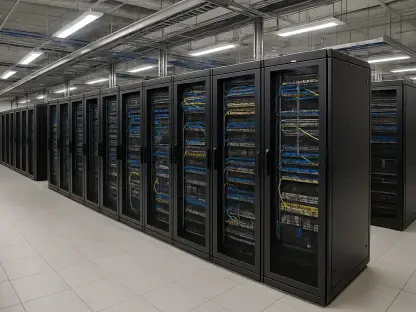The launch of the Aurora supercomputer by the United States Department of Energy’s Argonne National Laboratory represents a monumental advancement in the field of high-performance, exascale computing. This groundbreaking system emerges from a collaboration among government entities and industry giants like Intel and Hewlett Packard Enterprise. Positioned as a strategic asset, Aurora is set to spearhead significant breakthroughs across diverse scientific disciplines, including energy, medicine, aerospace, and quantum computing. By integrating artificial intelligence, large-scale simulations, and data analysis at unrivaled speeds, Aurora is anticipated to redefine the supercomputing landscape, establishing a new standard for technological potential.
Aurora’s Impact on National Interest and AI
At its inauguration, US Secretary of Energy Chris Wright likened Aurora’s development to the Manhattan Project, underscoring its potential to maintain America’s competitive edge in critical sectors. Highlighting areas of national interest such as artificial intelligence, scientific exploration, and national security, Wright emphasized the importance of continuous technological advancement. This declaration stresses the significance of maintaining a leadership position, especially in the realm of AI, a field critical not only for economic growth but also for strategic security. Aurora’s capability to enhance these domains promises to empower extensive research and innovation.
Aurora has quickly established itself among the most formidable computing systems globally, achieving exascale performance with the capability of processing over a quintillion calculations per second. It stands alongside other titans like the DOE’s Frontier and El Capitan supercomputers. Aurora is particularly notable for its exceptional standing on the TOP500 list and the HPL-MxP benchmark, both of which evaluate AI performance. Boasting 63,744 GPUs, it is one of the largest GPU-powered systems worldwide. The implementation of Intel’s unified architecture facilitates a powerful alliance between AI and high-performance computing, advancing scientific understanding significantly across multiple fields.
Scientific Applications and Infrastructure
Aurora’s innovations extend far beyond its computational capability, also encompassing its tangible infrastructure. Situated within the Argonne Leadership Computing Facility, Aurora occupies a sprawling 10,000-square-foot area, akin to the size of two basketball courts. The facility houses an intricate network with over 300 miles of cabling and nearly 85,000 connection endpoints, featuring a state-of-the-art water-cooling system to counter the intense heat produced during operations. This sophisticated setup underpins the supercomputer’s function, ensuring sustained performance levels required for handling vast computational demands.
Scientifically, Aurora has already made notable impacts across various disciplines. In biomedical research, it has propelled significant advancements, allowing researchers to model viral evolution, refine cancer treatment methodologies, and map brain connectivity with unparalleled clarity. The integrated use of AI with traditional physics-based simulations enhances drug discovery processes and improves public health responsiveness. The capacity to devise rapid solutions to potential pandemics and complex diseases positions Aurora as an indispensable asset in global health initiatives. These achievements highlight its role in transforming the landscape of medical research and preparedness.
Advances in Aerospace, Energy, and Quantum Computing
Aurora’s computational prowess is not limited to medicine. It extends to revolutionizing aerospace engineering by providing superior simulation capabilities for airflow dynamics, including turbulence, aerodynamics, and shock waves. These enhanced simulations facilitate modeling for next-generation aircraft and propulsion systems, greatly reducing reliance on physical prototypes. Consequently, this accelerates the design of more fuel-efficient and quieter aircraft, contributing to advancements in aerodynamics and engineering precision.
In energy research, especially fusion energy, Aurora showcases tremendous potential by simulating the extreme conditions present within fusion reactors. It significantly aids projects like the international ITER initiative, thus advancing the quest for sustainable fusion power. With AI prediction models, researchers can forecast the behavior of energetic particles, making strides towards controlled fusion energy, which could transform global energy consumption patterns. Aurora’s applications in this sector underscore its importance in paving the way for breakthrough energy solutions.
Quantum computing also reaps the benefits of Aurora’s capabilities, with researchers employing its power to study principles such as quantum randomness, essential for secure communications. By simulating quantum algorithms, Aurora facilitates the convergence of quantum and classical computations, tackling previously insurmountable scientific challenges. This synergy between advanced technologies fosters the development of solutions to complex molecular problems, exemplifying the transformative potential inherent in combining traditional and quantum computing paradigms.
Collaborations and Future Prospects
The United States Department of Energy’s Argonne National Laboratory recently launched the Aurora supercomputer, marking a significant leap in high-performance exascale computing. This cutting-edge system is the result of collaboration between government agencies and industry leaders such as Intel and Hewlett Packard Enterprise. Aurora is strategically positioned to trailblaze advancements across a variety of scientific fields, including energy, medicine, aerospace, and quantum computing. By integrating artificial intelligence, extensive simulations, and rapid data analysis, Aurora aims to overhaul the supercomputing landscape by achieving unprecedented speeds. This initiative will set new benchmarks for technological potential, enabling U.S. researchers and scientists to conduct more complex and accurate analyses than ever before. Aurora isn’t just an advancement in computing power; it’s a crucial tool for solving some of the world’s most pressing scientific and technological challenges. The project signifies a critical step forward in maintaining the nation’s leadership in global technological innovation.









